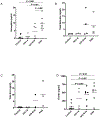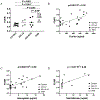Intraventricular Hemorrhage Clearance in Human Neonatal Cerebrospinal Fluid: Associations With Hydrocephalus
- PMID: 32397930
- PMCID: PMC7253327
- DOI: 10.1161/STROKEAHA.119.028744
Intraventricular Hemorrhage Clearance in Human Neonatal Cerebrospinal Fluid: Associations With Hydrocephalus
Abstract
Background and Purpose- Preterm neonates with intraventricular hemorrhage (IVH) are at risk for posthemorrhagic hydrocephalus and poor neurological outcomes. Iron has been implicated in ventriculomegaly, hippocampal injury, and poor outcomes following IVH. We hypothesized that levels of cerebrospinal fluid blood breakdown products and endogenous iron clearance proteins in neonates with IVH differ from those of neonates with IVH who subsequently develop posthemorrhagic hydrocephalus. Methods- Premature neonates with an estimated gestational age at birth <30 weeks who underwent lumbar puncture for clinical evaluation an average of 2 weeks after birth were evaluated. Groups consisted of controls (n=16), low-grade IVH (grades I-II; n=4), high-grade IVH (grades III-IV; n=6), and posthemorrhagic hydrocephalus (n=9). Control subjects were preterm neonates born at <30 weeks' gestation without brain abnormality or hemorrhage on cranial ultrasound, who underwent lumbar puncture for clinical purposes. Cerebrospinal fluid hemoglobin, total bilirubin, total iron, ferritin, ceruloplasmin, transferrin, haptoglobin, and hemopexin were quantified. Results- Cerebrospinal fluid hemoglobin levels were increased in posthemorrhagic hydrocephalus compared with high-grade IVH (9.45 versus 6.06 µg/mL, P<0.05) and cerebrospinal fluid ferritin levels were increased in posthemorrhagic hydrocephalus compared with controls (511.33 versus 67.08, P<0.01). No significant group differences existed for the other cerebrospinal fluid blood breakdown and iron-handling proteins tested. We observed positive correlations between ventricular enlargement (frontal occipital horn ratio) and ferritin (Pearson r=0.67), hemoglobin (Pearson r=0.68), and total bilirubin (Pearson r=0.69). Conclusions- Neonates with posthemorrhagic hydrocephalus had significantly higher levels of hemoglobin than those with high-grade IVH. Levels of blood breakdown products, hemoglobin, ferritin, and bilirubin correlated with ventricular size. There was no elevation of several iron-scavenging proteins in cerebrospinal fluid in neonates with posthemorrhagic hydrocpehalus, indicative of posthemorrhagic hydrocephalus as a disease state occurring when endogenous iron clearance mechanisms are overwhelmed.
Keywords: biomarkers; cerebrospinal fluid; hemorrhage; hydrocephalus; iron.
Conflict of interest statement
Conflict(s) of Interest/Disclosure(s)
David Limbrick, Jr., MD, PhD reports funding for research supported by Microbot Medical Inc. for work unrelated to this submitted work. The authors have no other relevant conflict(s) of interest or disclosure(s).
Figures




Similar articles
-
Elevated cerebrospinal fluid iron and ferritin associated with early severe ventriculomegaly in preterm posthemorrhagic hydrocephalus.J Neurosurg Pediatr. 2022 May 27;30(2):169-176. doi: 10.3171/2022.4.PEDS21463. Print 2022 Aug 1. J Neurosurg Pediatr. 2022. PMID: 35916101 Free PMC article.
-
Longitudinal CSF Iron Pathway Proteins in Posthemorrhagic Hydrocephalus: Associations with Ventricle Size and Neurodevelopmental Outcomes.Ann Neurol. 2021 Aug;90(2):217-226. doi: 10.1002/ana.26133. Epub 2021 Jun 25. Ann Neurol. 2021. PMID: 34080727 Free PMC article.
-
Outcomes of intraventricular hemorrhage and posthemorrhagic hydrocephalus in a population-based cohort of very preterm infants born to residents of Nova Scotia from 1993 to 2010.J Neurosurg Pediatr. 2015 Jun;15(6):580-8. doi: 10.3171/2014.11.PEDS14364. Epub 2015 Mar 13. J Neurosurg Pediatr. 2015. PMID: 26030329
-
Mechanisms of neuroinflammation in hydrocephalus after intraventricular hemorrhage: a review.Fluids Barriers CNS. 2022 Apr 1;19(1):28. doi: 10.1186/s12987-022-00324-0. Fluids Barriers CNS. 2022. PMID: 35365172 Free PMC article. Review.
-
Early intervention and neurodevelopmental outcome of infants with posthemorrhagic hydrocephalus: A case series and literature review.Clin Neurol Neurosurg. 2021 Feb;201:106432. doi: 10.1016/j.clineuro.2020.106432. Epub 2020 Dec 17. Clin Neurol Neurosurg. 2021. PMID: 33383466 Review.
Cited by
-
Novel therapeutics for hydrocephalus: Insights from animal models.CNS Neurosci Ther. 2021 Jun 20;27(9):1012-22. doi: 10.1111/cns.13695. Online ahead of print. CNS Neurosci Ther. 2021. PMID: 34151523 Free PMC article. Review.
-
Neurodevelopmental outcomes of neonatal posthemorrhagic hydrocephalus and psychological effects on the parents.Childs Nerv Syst. 2023 Aug;39(8):2115-2122. doi: 10.1007/s00381-023-05935-y. Epub 2023 Apr 20. Childs Nerv Syst. 2023. PMID: 37081233 Free PMC article.
-
Ultrasound-assisted neuroendoscopic lavage for intraventricular hemorrhage in a newborn: illustrative case.J Neurosurg Case Lessons. 2021 Jun 7;1(23):CASE2196. doi: 10.3171/CASE2196. eCollection 2021 Jun 7. J Neurosurg Case Lessons. 2021. PMID: 36046511 Free PMC article.
-
Does ventricle size contribute to cognitive outcomes in posthemorrhagic hydrocephalus? Role of early definitive intervention.J Neurosurg Pediatr. 2021 Oct 15;29(1):10-20. doi: 10.3171/2021.4.PEDS212. Print 2022 Jan 1. J Neurosurg Pediatr. 2021. PMID: 34653990 Free PMC article.
-
The Frequency of Intraventricular Hemorrhage and its Risk Factors.Curr Pediatr Rev. 2024;20(4):548-553. doi: 10.2174/0115733963252541231214045604. Curr Pediatr Rev. 2024. PMID: 38275024
References
-
- Christian EA, Jin DL, Attenello F, Wen T, Cen S, Mack WJ, et al. Trends in hospitalization of preterm infants with intraventricular hemorrhage and hydrocephalus in the United States, 2000–2010. J Neurosurg Pediatr. 2016;17:260–269. - PubMed
Publication types
MeSH terms
Grants and funding
LinkOut - more resources
Full Text Sources
Medical

